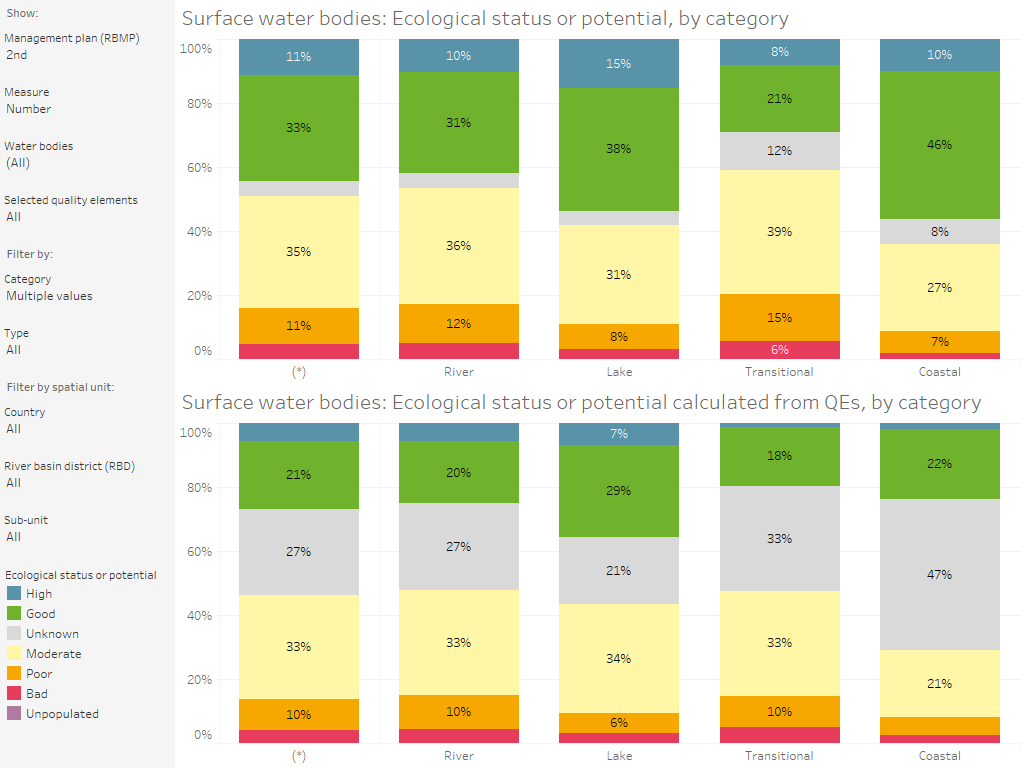All official European Union website addresses are in the europa.eu domain.
See all EU institutions and bodiesWithin the Water Framework Directive, two status assessments for surface waters are conducted: Ecological Status and Chemical Status. Ecological Status provides a composite assessment of the quality of surface water ecosystems, reflecting the cumulative effects of various pressures like pollution, habitat degradation, and climate change.
Ecological status is assessed for all water bodies designated in rivers, lakes, transitional and coastal waters. It is based on assessing the status of biological quality elements and supported by physico‑chemical and hydromorphological quality. The outcome of the ecological status assessment falls into one of five status classes. The overall objective is to achieve good or high status.
Other WFD pages:
- Surface water ecological status
Did you know?
In Europe, 40% of the surface water bodies are in good or high ecological status
Lakes and coastal waters have better status than rivers and transitional waters
Since 2009, biological quality elements in some water bodies have improved, but not enough to improve the overall ecological status
Assessment of ecological status of surface water bodies
Source: European waters. Assessment of status and pressures 2018. EEA Report No 7/2018
Ecological Status assessments are performed by all EU Member States every 6 years, in 2009, 2015, and 2021. On the scale of Europe, around 40% of the surface water bodies are in good or high ecological status, with lakes and coastal waters having better status than rivers and transitional waters. The overall ecological status has not improved since 2009 but it has improved for some biological quality elements between 2009 and 2015. The results of the 2021 assessments are not yet known.
The ecological status for a water body is determined according to the 'one out, all out' principle. This principle implies that a water body can only achieve good status if all biological and supporting quality elements are assessed at least as good. In other words, the quality element with the worst status determines the overall status.
Water bodies in moderate, poor or bad ecological status require mitigation and restoration to achieve the good status objective. To plan such measures, the pressures that prevent water bodies from achieving good ecological status must be identified. These pressures include point sources of pollution, diffuse sources of pollution, water abstraction, and hydrological and morphological alterations. Types of impacts include nutrients, organic and chemical pollution, altered habitats and acidification.
Surface water bodies: Ecological status or potential, by category. Second River Basin Management Plan

The spatial distribution of ecological status is shown on the map below. The blue areas show where more than half of water bodies are in good ecological status. These are found in the northern countries, particularly the northern Scandinavian region and Scotland, as well as Estonia, Romania, Slovakia and in the Mediterranean region. In contrast, red areas show where less than half of water bodies achieve good ecological status. These tend to be found in central Europe.
Water bodies failing to achieve good ecological status, by River Basin District

References
- European waters. Assessment of status and pressures 2018. EEA Report No 7/2018